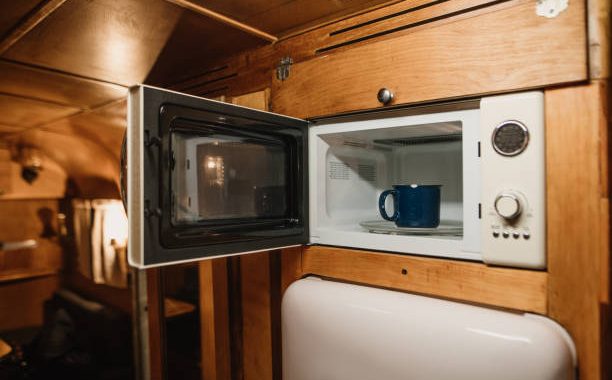Power is supplied via a special cable to the filter board It has a choke, a fuse (usually rated at about 10A), connecting wires, etc. If the microwave turns on, then there are no problems with this circuit and everything is most likely working properly.
Tip: try to avoid heating metal objects or containers with a metal coating in the microwave oven
Next, power is supplied to the control board, which is of three types:
– mechanical;
– push-button;
– touch
The next device in this chain is a transformer, which is necessary to increase (convert) the voltage from 220 V to about 2500 V and above. It has a primary and high-voltage winding, from which the voltage is supplied to a special high-voltage fuse through the terminal.
Be careful, when diagnosing the microwave, even in the off-state, as an electric shock may occur
The power of modern microwave ovens is in the range from 500 to 2500 W, in some models it can be higher. Microwaves operate at a frequency of 2450 MHz, in the USA – 915 MHz.
Interesting to know. One of the most common myths about microwave ovens is that ultra-high-frequency radiation changes the structure of the products that we heat in it every day and turns them into a mountain of carcinogens. In fact, the energy of microwave radiation is too small to change the structure of food when heated.
One of the reasons why the microwave stopped heating may be a blown fuse
To check the functionality of the high-voltage fuse, you will need to disassemble the microwave oven to gain access to it. It is located in this case in a white protective casing.
You can determine its condition by external signs or using a special multimeter tool by setting the required mode on it (for example, by selecting the ringing mode).
How to replace the high-voltage fuse in the microwave? If this element of the electrical circuit does not show signs of life and the ringing showed its malfunction, we recommend replacing it with a new one of the same rating. A faulty fuse can also be the reason why the microwave oven does not turn on.
We do not recommend using so-called “bugs” and other temporary devices.
If the microwave heats poorly – check the voltage in the network
The operating voltage required for the proper operation of the microwave is indicated in the user manual, on the body of the device itself, or on the official website of the manufacturer. As a rule, it is 220 V. To measure it, use a tester, setting the regulator to the desired position.
If the readings are less than recommended by 10-15 V or more – the reason why the microwave turns on, but does not heat may be just that.
If you do not know how to do it correctly, it is better to contact the specialists that you can find on our website.
To avoid power surges, it is necessary to use a stabilizer, which will help to extinguish distortions in the power grid.
Also, to protect your equipment from current and voltage surges in the network can be a relay for monitoring the current and voltage, which, when reaching the limit values both up and down, simply de-energizes the devices for a while and turns on automatically when the indicators specified in the settings are reached.
It will not be superfluous to check for performance and the outlet itself, where you connected the microwave oven. This can be done with the same ohmmeter or by connecting any other household appliance.
Whether you can find the breakdown yourself or at some stage of the search call the master – you decide. We only note that in the absence of experience in disassembling and assembling the microwave, it is better to limit yourself to external inspection and search for simple damage, and then call our master. Chula Vista Appliance Repair Company is pleased to offer efficient microwave repair services in and around San Diego County. Our team of experts is well-equipped and ready to handle all types of microwave repairs, no matter how complex. We strive to provide superior repairs using only the highest quality replacement parts backed by the manufacturer’s warranty, so you can rely on a microwave repair technician to fix the problem and keep your microwave working properly for a long time.
Contact us
(619) 880-5508


